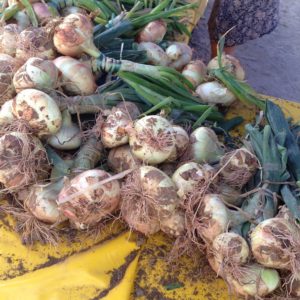It seems odd that a town would name itself after an onion, but that appears to be what Lezignan la Cebe has done.
“Cebe” comes from the Occitan word for “onion”, and about 500 years ago the local people began referring to their town by that name.
Here is the google-translate version of the Lezignan la Cebe wiki page.
Going with that name is not much different than calling themselves “Onionville” … but it seems to work for them.
And they are owning that distinction with their annual Sweet Onion Fair.
Back in California, several small towns have decided they are the “world capital” of this or that vegetable. Gilroy and garlic. Holtville and carrots. Castroville and artichokes.
Until arriving at the fair site, however, I didn’t know this nearby town had named itself after onions. Not knowing that “cebe” meant onion in Occitan, the former language of this area.
(In French, onion is oignon.)
But they grow pretty good onions here.
They tend to be big and crisp, and I suppose a person could eat one like an apple — after washing off the dirt, of course. And then eating a mint or five.
Befitting an onion fair, various mom-and-pop food booths sold items made with local onions. The omelet lady. The lamb-skewer couple.
One booth, run by the town, featured unusual applications for the local onions, including an onion ice cream. No, really. It was … weird.
Pork cheeks with local onions seem to work better, thank you.
And, of course, as you do at the fair … you have a “biggest” competition — which was won by a local guy who had grown his monster onion in his backyard, not in some commercial patch.
It weighed in at almost three pounds, if we heard correctly, and the somewhat bashful citizen came forward to pick up the winner’s cup and pose for photos. The monster onion was hung from a stake, where we could admire it.
Lezignan la Cebe’s onions seem to have a long season. We were seeing them packaged in bunches of five (who can eat that many onions?) at local supermarkets back in May, and only now, in July, are they having the fair.
The event included a troupe of middle-aged singers and dancers from another nearby town, and they seemed to have fun … and the swelling crowd seemed to like them … and then came the onion contest, and then a rock-and-roll band began playing.
Attendance went from about 200 to about 500 as the dinner hour approached, which is about 7:30 p.m. here in the south of France.
The lady making cheese-and-onion omelets ran out of eggs as we were standing in line so we settled for the lamb skewers (three of them) for 6 euros, and then a tomato-and-onion salad with half a baguette for 1.50 euros.
Beer on tap was 2 euros (about $2.25) and wine from nearby vintners was 1 euro per cup.
A homemade-ice-cream stand did land-office business, and the honey man also sold honey-flavored ice cream. (I had the honey and peach.)
The Sweet Onion Fair was another example of the many community-oriented events staged in the little towns of the Languedoc. They seem to get nice crowds of local people who know most everyone in the town. (For a long time we may have been the only anglophones in the place.)
No one in this part of France seems to think it strange to have three generations of residents attending the same event. It happens all the time around here.
As we left, the band was taking a break to eat something (with onions in it, no doubt), and the festivities were due to run till midnight — by which time everyone should have had their fill of the eighth annual Sweet Onion Fair over in Onionville.


0 responses so far ↓
There are no comments yet...Kick things off by filling out the form below.
Leave a Comment